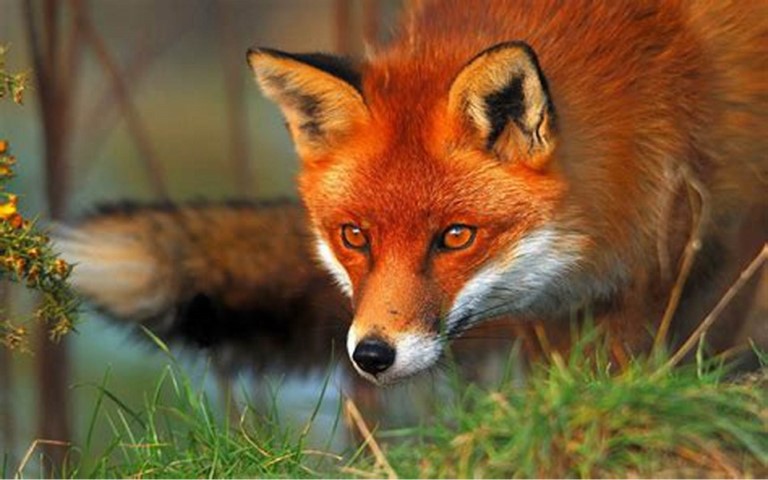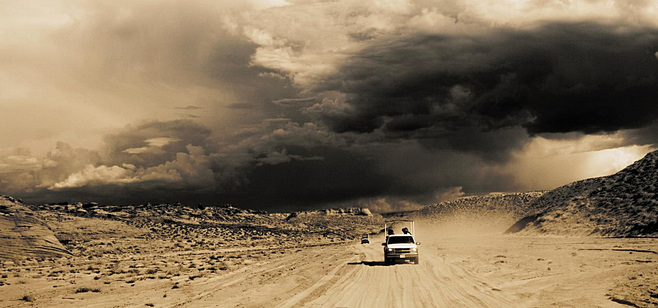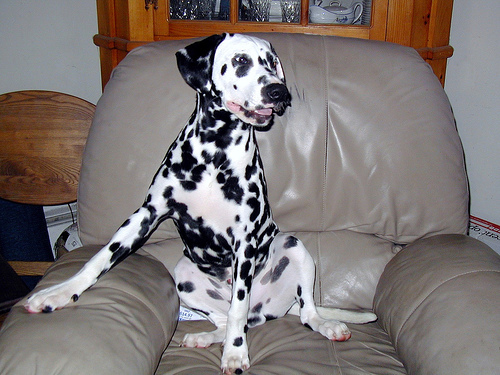CAM
- CAM
- Ablation-CAM
- Eigen-CAM
- EigenGrad-CAM
- Full-Grad
- Grad-CAM
- Grad-CAM++
- Grad-CAM-ElementWise
- HiResCAM
- Layer-CAM
- RandomCAM
- Score-CAM
- XGrad-CAM
- Relevance-CAM
Integrated Gradients
- IG
- IGOS
- Guided IG
- Enhanced Integrated Gradients
LIME
- Lime
- BayLime
LRP
- LRP
新方法
- Activation Maximization
- Sensitivity Analysis(Pytorch)
- Simple Taylor Decomposition
- Deep Taylor Decomposition
- DeepLift(Pytorch/TensorFlow)【False,似乎不支持比较复杂的模型,不能有两个以上的ReLU】
- Deconvolution(Pytorch)
- Backpropagation
- Guided Backpropagation
- SmoothGrad
- Explanation Continuity
- Explanation Selectivity
解释模型:ResNet50、VGG19(权重及模型从Pytorch包直接导入)
原始图片:
预测结果:alp(高山,0.67)、jeep(吉普车,0.95)、jeep(吉普车,0.40)、dalmatian(达尔马提亚狗,0.999)
ResNet50
VGG19
左侧为VGG19,右侧为ResNet50
在所有CAM解释方法中,颜色越红表示对分类作用越强烈作用
其中蓝色部分是对分类有正向作用的部分
### LRP越亮的点表示对分类的作用越强烈
### Guided IG# 获取权重并转化为热力图
def makeCAM(feature, weights, classes_id):
print(feature.shape, weights.shape, classes_id)
# batchsize, C, h, w
bz, nc, h, w = feature.shape
# (512,) @ (512, 7*7) = (49,)
cam = weights[classes_id].dot(feature.reshape(nc, h * w))
cam = cam.reshape(h, w) # (7, 7)
# 归一化到[0, 1]之间
cam = (cam - cam.min()) / (cam.max() - cam.min())
# 转换为0~255的灰度图
cam_gray = np.uint8(255 * cam)
# 最后,上采样操作,与网络输入的尺寸一致,并返回
return cv2.resize(cam_gray, (224, 224))
for img in os.listdir(input_path):
img_path = os.path.join(input_path, img)
# 定义预训练模型: resnet18、resnet50、densenet121
resnet18 = models.resnet18(pretrained=True)
resnet50 = models.resnet50(pretrained=True)
densenet121 = models.densenet121(pretrained=True)
resnet18.eval()
resnet50.eval()
densenet121.eval()
# hook用于获取变量的中间结果
# =====注册hook start=====
feature_data = []
resnet18._modules.get('layer4').register_forward_hook(feature_hook)
resnet50._modules.get('layer4').register_forward_hook(feature_hook)
densenet121._modules.get('features').register_forward_hook(feature_hook)
# =====注册hook end=====
# 获取fc层的权重
fc_weights_resnet18 = resnet18._modules.get('fc').weight.data.numpy()
fc_weights_resnet50 = resnet50._modules.get('fc').weight.data.numpy()
fc_weights_densenet121 = densenet121._modules.get('classifier').weight.data.numpy()
# 图片数据转换
image_transform = transforms.Compose([
# 将输入图片resize成统一尺寸
transforms.Resize([224, 224]),
# 将图片灰度值255归一化到[0,1]之间
transforms.ToTensor(),
# 标准化处理
transforms.Normalize(
mean=[0.485, 0.456, 0.406],
std=[0.229, 0.224, 0.225]
)
])
# 获取预测类别id
image = image_transform(Image.open(img_path)).unsqueeze(0)
out_resnet18 = resnet18(image)
out_resnet50 = resnet50(image)
out_densenet121 = densenet121(image)
predict_classes_id_resnet18 = np.argmax(F.softmax(out_resnet18, dim=1).data.numpy())
predict_classes_id_resnet50 = np.argmax(F.softmax(out_resnet50, dim=1).data.numpy())
predict_classes_id_densenet121 = np.argmax(F.softmax(out_densenet121, dim=1).data.numpy())
# 将全连接层的权重转化为热力图及cam
cam_gray_resnet18 = makeCAM(feature_data[0], fc_weights_resnet18, predict_classes_id_resnet18)
cam_gray_resnet50 = makeCAM(feature_data[1], fc_weights_resnet50, predict_classes_id_resnet50)
cam_gray_densenet121 = makeCAM(feature_data[2], fc_weights_densenet121, predict_classes_id_densenet121)
# 叠加CAM和原图,并保存图片
# 1)读取原图
src_image = cv2.imread(img_path)
h, w, _ = src_image.shape
# 2)cam转换成与原图大小一致的彩色度(cv2.COLORMAP_HSV为彩色图的其中一种类型)
cam_color_resnet18 = cv2.applyColorMap(cv2.resize(cam_gray_resnet18, (w, h)),
cv2.COLORMAP_HSV)
cam_color_resnet50 = cv2.applyColorMap(cv2.resize(cam_gray_resnet50, (w, h)),
cv2.COLORMAP_HSV)
cam_color_densenet121 = cv2.applyColorMap(cv2.resize(cam_gray_densenet121, (w, h)),
cv2.COLORMAP_HSV)
# 3)合并cam和原图,并保存
cam_resnet18 = src_image * 0.5 + cam_color_resnet18 * 0.5
cam_resnet50 = src_image * 0.5 + cam_color_resnet50 * 0.5
cam_densenet121 = src_image * 0.5 + cam_color_densenet121 * 0.5
cam_hstack = np.hstack((src_image, cam_resnet18, cam_resnet50, cam_densenet121))
cv2.imwrite(os.path.join(output_path,"result_"+img), cam_hstack)class GradCAM(BaseCAM):
def __init__(self, model, target_layers, use_cuda=False,
reshape_transform=None):
super(
GradCAM,
self).__init__(
model,
target_layers,
use_cuda,
reshape_transform)
def get_cam_weights(self,
input_tensor,
target_layer,
target_category,
activations,
grads):
return np.mean(grads, axis=(2, 3))
cam_algorithm = GradCAM
with cam_algorithm(model=model,
target_layers=target_layers,
use_cuda=use_cuda) as cam:
cam.batch_size = 32
grayscale_cam = cam(input_tensor=input_tensor,
targets=targets,
aug_smooth=False,
eigen_smooth=False)
grayscale_cam = grayscale_cam[0, :]
cam_image = show_cam_on_image(rgb_img, grayscale_cam, use_rgb=True)
# 将RGB图转化为BGR图,便于opencv显示
cam_image = cv2.cvtColor(cam_image, cv2.COLOR_RGB2BGR)
gb_model = GuidedBackpropReLUModel(model=model, use_cuda=use_cuda)
gb = gb_model(input_tensor, target_category=None)
cam_mask = cv2.merge([grayscale_cam, grayscale_cam, grayscale_cam])
cam_gb = deprocess_image(cam_mask * gb)
gb = deprocess_image(gb)
cv2.imwrite(os.path.join(output_path, 'cam_' + img), cam_image)
cv2.imwrite(os.path.join(output_path, 'gb_' + img), gb)
cv2.imwrite(os.path.join(output_path, 'cam_gb_' + img), cam_gb)output[:, maxindex].sum().backward(retain_graph=True)
activation = value['activations'] # [1, 2048, 7, 7]
gradient = value['gradients'] # [1, 2048, 7, 7]
gradient_2 = gradient ** 2
gradient_3 = gradient ** 3
gradient_ = torch.mean(gradient, dim=(2, 3), keepdim=True)
grad_cam = activation * gradient_
grad_cam = torch.sum(grad_cam, dim=(0, 1))
grad_cam = torch.clamp(grad_cam, min=0)
grad_cam = grad_cam.data.cpu().numpy()
grad_cam = cv2.resize(grad_cam, (224, 224))
alpha_numer = gradient_2
alpha_denom = 2 * gradient_2 + torch.sum(activation * gradient_3, axis=(2, 3), keepdims=True) # + 1e-2
alpha = alpha_numer / alpha_denom
w = torch.sum(alpha * torch.clamp(gradient, 0), axis=(2, 3), keepdims=True)
grad_campp = activation * w
grad_campp = torch.sum(grad_campp, dim=(0, 1))
grad_campp = torch.clamp(grad_campp, min=0)
grad_campp = grad_campp.data.cpu().numpy()
grad_campp = cv2.resize(grad_campp, (224, 224))
score_map, _ = Score_CAM_class(in_tensor, class_idx=maxindex)
score_map = score_map.squeeze()
score_map = score_map.detach().cpu().numpy()
R_CAM = tensor2image(R_CAM)# 导入Resnet50模型
model = models.resnet50(pretrained=True)
# 变为预测
model = model.eval()
# 导入测试图像
img = Image.open('Images/3.JPEG')
'''
组合多个图像处理步骤
1. 调整PILImage对象的尺寸,将其短边缩放为256个像素
2. 从中心将图像切割为224*224的尺寸
3. 将图像的灰度范围从0-255放缩到0-1之间,并转化为张量格式
'''
transform = transforms.Compose([
transforms.Resize(256),
transforms.CenterCrop(224),
transforms.ToTensor()
])
'''
通过下面公式对RGB的灰度值进行标准化
x = (x - mean) / std
'''
transform_normalize = transforms.Normalize(
mean=[0.485, 0.456, 0.406],
std=[0.229, 0.224, 0.225]
)
# 图像预处理
transformed_img = transform(img)
# 标准化
input = transform_normalize(transformed_img)
# 在最外面加一个维度
input = input.unsqueeze(0)
# 传入模型进行预测
output = model(input)
# 将预测结果用softmax处理为概率格式
output = F.softmax(output, dim=1)
# 预测概率最大的值及其索引
prediction_score, pred_label_idx = torch.topk(output, 1)
# 实例化
integrated_gradients = IntegratedGradients(model)
# 返回与输入特征尺寸相同的特征重要性分数
attributions_ig = integrated_gradients.attribute(input, target=pred_label_idx, n_steps=200)
# 加噪声测试
noise_tunnel = NoiseTunnel(integrated_gradients)
# 向输入数据中添加噪声,按IG方法归因,最终返回采样属性的平均值
attributions_ig_nt = noise_tunnel.attribute(input, nt_samples=10, nt_type='smoothgrad_sq', target=pred_label_idx)
# 展示原图和归因结果
_ = viz.visualize_image_attr_multiple(np.transpose(attributions_ig_nt.squeeze().cpu().detach().numpy(), (1,2,0)),
np.transpose(transformed_img.squeeze().cpu().detach().numpy(), (1,2,0)),
["original_image", "heat_map"],
["all", "positive"],
cmap='gray',
show_colorbar=True)def Get_blurred_img(input_img, img_label, model, resize_shape=(224, 224), Gaussian_param = [51, 50], Median_param = 11, blur_type= 'Gaussian', use_cuda = 1):
"""
返回值:img, blurred_img, logitori
img-----------将原始图像的灰度值从255放缩到0-1之间
blurred_img---对输入图像进行高斯滤波获得基线图像
logitori------Resnet50的原始预测结果
"""
original_img = cv2.imread(input_img, 1)
original_img = cv2.resize(original_img, resize_shape)
img = np.float32(original_img) / 255
if blur_type =='Gaussian': # Gaussian blur
Kernelsize = Gaussian_param[0]
SigmaX = Gaussian_param[1]
blurred_img = cv2.GaussianBlur(img, (Kernelsize, Kernelsize), SigmaX)
elif blur_type == 'Median': # Median blur
Kernelsize_M = Median_param
blurred_img = np.float32(cv2.medianBlur(original_img, Kernelsize_M)) / 255
elif blur_type == 'Mixed': # Mixed blur
Kernelsize = Gaussian_param[0]
SigmaX = Gaussian_param[1]
blurred_img1 = cv2.GaussianBlur(img, (Kernelsize, Kernelsize), SigmaX)
Kernelsize_M = Median_param
blurred_img2 = np.float32(cv2.medianBlur(original_img, Kernelsize_M)) / 255
blurred_img = (blurred_img1 + blurred_img2) / 2
img_torch = preprocess_image(img, use_cuda, require_grad = False)
blurred_img_torch = preprocess_image(blurred_img, use_cuda, require_grad = False)
ori_output = model(img_torch)
blurred_output = model(blurred_img_torch)
# compute the outputs for the original image and the blurred image
if use_cuda:
logitori = ori_output.data.cpu().numpy().copy().squeeze()
logitblur = blurred_output.data.cpu().numpy().copy().squeeze()
else:
logitori = ori_output.data.numpy().copy().squeeze()
logitblur = blurred_output.data.cpu().numpy().copy().squeeze()
top_5_idx = np.argsort(logitori)[-5:]
top_5_values = [logitori[i] for i in top_5_idx]
print('top_5_idx:', top_5_idx, top_5_values)
# find the original top 1 classification label
rew = np.where(logitori == np.max(logitori))
#print(rew)
output_label = rew[0][0]
# if img_label=-1, choose the original top 1 label as the one that you want to visualize
if img_label == -1:
img_label = output_label
rew_blur = np.where(logitblur == np.max(logitblur))
output_label_blur = rew_blur[0][0]
#print('ori_output:', ori_output[0, img_label], output_label)
#print('blurred_output:', blurred_output[0, img_label], output_label_blur)
blur_ratio = blurred_output[0, img_label] / ori_output[0, img_label]
#print('blur_ratio:', blur_ratio)
return img, blurred_img, logitori
def Integrated_Mask(img, blurred_img, model, category, max_iterations = 15, integ_iter = 20,
tv_beta=2, l1_coeff = 0.01*300, tv_coeff = 0.2*300, size_init = 112, use_cuda =1):
# 对输入图像和基线图像进行预处理
img = preprocess_image(img, use_cuda, require_grad=False)
blurred_img = preprocess_image(blurred_img, use_cuda, require_grad=False)
resize_size = img.data.shape
resize_wh = (img.data.shape[2], img.data.shape[3])
if use_cuda:
zero_img = Variable(torch.zeros(resize_size).cuda(), requires_grad=False)
else:
zero_img = Variable(torch.zeros(resize_size), requires_grad=False)
# 初始化mask
mask_init = np.ones((size_init, size_init), dtype=np.float32)
mask = numpy_to_torch(mask_init, use_cuda, requires_grad=True)
# 采用双线性插值将mask上采样到输入图像大小
if use_cuda:
upsample = torch.nn.UpsamplingBilinear2d(size=resize_wh).cuda()
else:
upsample = torch.nn.UpsamplingBilinear2d(size=resize_wh)
# 采样Adam优化器优化目标函数
optimizer = torch.optim.Adam([mask], lr=0.1)
#optimizer = torch.optim.SGD([mask], lr=0.1)
target = torch.nn.Softmax(dim=1)(model(img))
if use_cuda:
category_out = np.argmax(target.cpu().data.numpy())
else:
category_out = np.argmax(target.data.numpy())
# if category=-1, choose the original top 1 category as the one that you want to visualize
if category ==-1:
category = category_out
print("Category with highest probability", category_out)
print("Category want to generate mask", category)
print("Optimizing.. ")
curve1 = np.array([])
curve2 = np.array([])
curvetop = np.array([])
# 梯度下降
alpha = 0.0001
beta = 0.2
for i in range(max_iterations):
upsampled_mask = upsample(mask)
'''
将单通道的mask和RGB图像混合使用
'''
upsampled_mask = \
upsampled_mask.expand(1, 3, upsampled_mask.size(2), \
upsampled_mask.size(3))
# the l1 term and the total variation term
loss1 = l1_coeff * torch.mean(torch.abs(1 - mask)) + \
tv_coeff * tv_norm(mask, tv_beta)
loss_all = loss1.clone()
# 计算扰动图片
perturbated_input_base = img.mul(upsampled_mask) + \
blurred_img.mul(1 - upsampled_mask)
for inte_i in range(integ_iter):
# 向图像中加入mask
integ_mask = 0.0 + ((inte_i + 1.0) / integ_iter) * upsampled_mask
perturbated_input_integ = img.mul(integ_mask) + \
blurred_img.mul(1 - integ_mask)
# 加入噪声
noise = np.zeros((resize_wh[0], resize_wh[1], 3), dtype=np.float32)
noise = noise + cv2.randn(noise, 0, 0.2)
noise = numpy_to_torch(noise, use_cuda, requires_grad=False)
perturbated_input = perturbated_input_integ + noise
new_image = perturbated_input
outputs = torch.nn.Softmax(dim=1)(model(new_image))
loss2 = outputs[0, category]
loss_all = loss_all + loss2/20.0
# 计算给定目标积分梯度
# 计算L1范数和总变化的梯度
optimizer.zero_grad()
loss_all.backward()
whole_grad = mask.grad.data.clone()
loss2_ori = torch.nn.Softmax(dim=1)(model(perturbated_input_base))[0, category]
loss_ori = loss1 + loss2_ori
if i==0:
if use_cuda:
curve1 = np.append(curve1, loss1.data.cpu().numpy())
curve2 = np.append(curve2, loss2_ori.data.cpu().numpy())
curvetop = np.append(curvetop, loss2_ori.data.cpu().numpy())
else:
curve1 = np.append(curve1, loss1.data.numpy())
curve2 = np.append(curve2, loss2_ori.data.numpy())
curvetop = np.append(curvetop, loss2_ori.data.numpy())
if use_cuda:
loss_oridata = loss_ori.data.cpu().numpy()
else:
loss_oridata = loss_ori.data.numpy()
# 进行路径搜索
step = 200.0
MaskClone = mask.data.clone()
MaskClone -= step * whole_grad
MaskClone = Variable(MaskClone, requires_grad=False)
MaskClone.data.clamp_(0, 1)
mask_LS = upsample(MaskClone)
Img_LS = img.mul(mask_LS) + \
blurred_img.mul(1 - mask_LS)
outputsLS = torch.nn.Softmax(dim=1)(model(Img_LS))
loss_LS = l1_coeff * torch.mean(torch.abs(1 - MaskClone)) + \
tv_coeff * tv_norm(MaskClone, tv_beta) + outputsLS[0, category]
if use_cuda:
loss_LSdata = loss_LS.data.cpu().numpy()
else:
loss_LSdata = loss_LS.data.numpy()
new_condition = whole_grad ** 2 # Here the direction is the whole_grad
new_condition = new_condition.sum()
new_condition = alpha * step * new_condition
while loss_LSdata > loss_oridata - new_condition.cpu().numpy():
step *= beta
MaskClone = mask.data.clone()
MaskClone -= step * whole_grad
MaskClone = Variable(MaskClone, requires_grad=False)
MaskClone.data.clamp_(0, 1)
mask_LS = upsample(MaskClone)
Img_LS = img.mul(mask_LS) + \
blurred_img.mul(1 - mask_LS)
outputsLS = torch.nn.Softmax(dim=1)(model(Img_LS))
loss_LS = l1_coeff * torch.mean(torch.abs(1 - MaskClone)) + \
tv_coeff * tv_norm(MaskClone, tv_beta) + outputsLS[0, category]
if use_cuda:
loss_LSdata = loss_LS.data.cpu().numpy()
else:
loss_LSdata = loss_LS.data.numpy()
new_condition = whole_grad ** 2 # Here the direction is the whole_grad
new_condition = new_condition.sum()
new_condition = alpha * step * new_condition
if step<0.00001:
break
mask.data -= step * whole_grad
if use_cuda:
curve1 = np.append(curve1, loss1.data.cpu().numpy())
curve2 = np.append(curve2, loss2_ori.data.cpu().numpy())
else:
curve1 = np.append(curve1, loss1.data.numpy())
curve2 = np.append(curve2, loss2_ori.data.numpy())
mask.data.clamp_(0, 1)
if use_cuda:
maskdata = mask.data.cpu().numpy()
else:
maskdata = mask.data.numpy()
maskdata = np.squeeze(maskdata)
maskdata, imgratio = topmaxPixel(maskdata, 40)
maskdata = np.expand_dims(maskdata, axis=0)
maskdata = np.expand_dims(maskdata, axis=0)
###############################################
if use_cuda:
Masktop = torch.from_numpy(maskdata).cuda()
else:
Masktop = torch.from_numpy(maskdata)
# Use the mask to perturbated the input image.
Masktop = Variable(Masktop, requires_grad=False)
MasktopLS = upsample(Masktop)
Img_topLS = img.mul(MasktopLS) + \
blurred_img.mul(1 - MasktopLS)
outputstopLS = torch.nn.Softmax(dim=1)(model(Img_topLS))
loss_top1 = l1_coeff * torch.mean(torch.abs(1 - Masktop)) + \
tv_coeff * tv_norm(Masktop, tv_beta)
loss_top2 = outputstopLS[0, category]
if use_cuda:
curvetop = np.append(curvetop, loss_top2.data.cpu().numpy())
else:
curvetop = np.append(curvetop, loss_top2.data.numpy())
if max_iterations >3:
if i == int(max_iterations / 2):
if np.abs(curve2[0] - curve2[i]) <= 0.001:
print('Adjust Parameter l1_coeff at iteration:', int(max_iterations / 2))
l1_coeff = l1_coeff / 10
elif i == int(max_iterations / 1.25):
if np.abs(curve2[0] - curve2[i]) <= 0.01:
print('Adjust Parameters l1_coeff again at iteration:', int(max_iterations / 1.25))
l1_coeff = l1_coeff / 5
# 采用双线性插值将mask上采样到输入图像大小
upsampled_mask = upsample(mask)
if use_cuda:
mask = mask.data.cpu().numpy().copy()
else:
mask = mask.data.numpy().copy()
return mask, upsampled_mask, imgratio, curvetop, curve1, curve2, category
#######################################################################################################################主要代码######################################
##################################################################################
input_img = os.path.join(input_path, imgname)
print('imgname:', imgname)
# 生成基线图像
img, blurred_img, logitori = Get_blurred_img(input_img, img_label=-1, model, resize_shape=(224, 224), Gaussian_param=[51, 50], Median_param=11, blur_type='Gaussian', use_cuda=use_cuda)
# 实现IGOS方法
mask, upsampled_mask, imgratio, curvetop, curve1, curve2, category = Integrated_Mask(img, blurred_img, model, img_label=-1, max_iterations=15, integ_iter=20, tv_beta=2, l1_coeff=0.01 * 100, tv_coeff=0.2 * 100, size_init=28, use_cuda=1)def test_model5(dataloader, dataset_size, model, device):
model.train(False)
for data in dataloader:
# get the inputs
#inputs, labels, filenames = data
inputs=data['image']
labels=data['label']
fns=data['filename']
inputs = inputs.to(device).clone()
labels = labels.to(device)
inputs.requires_grad=True
print(inputs.requires_grad)
with torch.enable_grad():
outputs = model(inputs)
vals,cls = torch.max(outputs, dim=1)
outputs[0,cls].backward()
print(inputs.grad.shape)
rel=inputs.grad.data
print( torch.max(rel), torch.mean(rel) )
clsss=get_classes()
with torch.no_grad():
print('shp ', outputs.shape)
vals,cls = torch.max(outputs, dim=1)
m=torch.mean(outputs)
print( vals.item(), clsss[cls.item()], m.item() )
print(fns)
# main 是否展示图片
imshow2(rel.to('cpu'),imgtensor = inputs.to('cpu'),fns=os.path.join(output_path, 'result_resnet_'+fns[0][-6:]),is_show=False)
def runstuff(skip, root_dir="./Images", use_cuda=True):
'''
skip:从第几张图片开始测试
root_dir:存放测试图片的文件夹
use_cude:是否使用GPU
'''
if use_cuda:
device=torch.device('cuda')
else:
device=torch.device('cpu')
#transforms
data_transform = transforms.Compose([
transforms.Resize(224),
transforms.CenterCrop(224),
transforms.ToTensor(),
transforms.Normalize(mean=[0.485, 0.456, 0.406],std=[0.229, 0.224, 0.225]) # if you do five crop, then you must change this part here, as it cannot be applied to 4 tensors
])
dset= dataset_imagenetvalpart_nolabels(root_dir, maxnum=1, skip=skip, transform=data_transform)
dataset_size=len(dset)
dataloader = torch.utils.data.DataLoader(dset, batch_size=1, shuffle=False) #, num_workers=1)
modeltrained = models.resnet18(pretrained=True).to(device)
model = resnet18_canonized(pretrained=False)
lrp_params_def1={
'conv2d_ignorebias': True,
'eltwise_eps': 1e-6,
'linear_eps': 1e-6,
'pooling_eps': 1e-6,
'use_zbeta': True ,
}
lrp_layer2method={
'nn.ReLU': relu_wrapper_fct,
'nn.BatchNorm2d': relu_wrapper_fct,
'nn.Conv2d': conv2d_beta0_wrapper_fct,
'nn.Linear': linearlayer_eps_wrapper_fct,
'nn.AdaptiveAvgPool2d': adaptiveavgpool2d_wrapper_fct,
'nn.MaxPool2d': maxpool2d_wrapper_fct,
'sum_stacked2': eltwisesum_stacked2_eps_wrapper_fct,
}
model.copyfromresnet(modeltrained, lrp_params=lrp_params_def1, lrp_layer2method = lrp_layer2method)
model = model.to(device)
test_model3(dataloader, dataset_size, modeltrained, device=device)
test_model3(dataloader, dataset_size, model, device=device)
test_model5(dataloader, dataset_size, model, device=device)# 加载模型
model = models.vgg19(pretrained=True)
model = model.eval()
# 图像预处理
transform = transforms.Compose([
transforms.Resize(256),
transforms.CenterCrop(224),
transforms.ToTensor()
])
transform_normalize = transforms.Normalize(
mean=[0.485, 0.456, 0.406],
std=[0.229, 0.224, 0.225]
)
# 读取索引对应的类别
labels_path = '../imagenet_class_index.json'
with open(labels_path) as json_data:
idx_to_labels = json.load(json_data)
def predict(imgs):
'''
img:将要预测的图像
'''
result = []
for img in imgs:
# 转换图像格式
img = cv2.cvtColor(img, cv2.COLOR_BGR2RGB)
img = Image.fromarray(img)
transformed_img = transform(img)
img = transform_normalize(transformed_img)
img = img.unsqueeze(0)
prediction_score, pred_label_idx = torch.topk(F.softmax(model(img), dim=1), 1)
pred_label_idx.squeeze_()
predicted_label = idx_to_labels[str(pred_label_idx.item())][1]
#print('Predicted:', predicted_label, '(', prediction_score.squeeze().item(), ')')
result.append(np.array([pred_label_idx, prediction_score.squeeze().item()]))
#return [(i,result[i]) for i in range(len(result))]
return result
# 进行扰动并保存结果
input_path = "../Images/"
output_path = "../Results/LIME"
if not os.path.isdir(output_path):
os.makedirs(output_path)
for image_path in os.listdir(input_path):
explainer = LimeImageExplainer()
explanation = explainer.explain_instance(
cv2.imread(os.path.join(input_path, image_path)),
predict, # classification function
top_labels=50,
hide_color=0,
num_samples=100)
#temp, mask = explanation.get_image_and_mask(explanation.top_labels[0], positive_only=True, num_features=5, hide_rest=False)
temp, mask = explanation.get_image_and_mask(explanation.top_labels[0], positive_only=False, num_features=5, hide_rest=False)
img_boundry1 = mark_boundaries(temp/255.0, mask)
cv2.imwrite(os.path.join(output_path, './result_vgg19_'+image_path), img_boundry1*255)

















